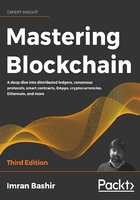
Platforms for decentralization
Today, there are many platforms available for decentralization. In fact, the fundamental feature of blockchain networks is to provide decentralization. Therefore, any blockchain network, such as Bitcoin, Ethereum, Hyperledger Fabric, or Quorum, can be used to provide a decentralization service. Many organizations around the world have introduced platforms that promise to make distributed application development easy, accessible, and secure. Some of these platforms are described as follows.
Ethereum
Ethereum tops the list as being the first blockchain to introduce a Turing-complete language and the concept of a virtual machine. This is in stark contrast to the limited scripting language in Bitcoin and many other cryptocurrencies. With the availability of its Turing-complete language, Solidity, endless possibilities have opened for the development of decentralized applications. This blockchain was first proposed in 2013 by Vitalik Buterin, and it provides a public blockchain to develop smart contracts and decentralized applications. Currency tokens on Ethereum are called ethers.
MaidSafe
This is a project for the decentralized Internet introduced in 2006. This is not a blockchain, but a decentralized and autonomous network.
MaidSafe provides a SAFE (Secure Access for Everyone) network that is made up of unused computing resources, such as storage, processing power, and the data connections of its users. The files on the network are divided into small chunks of data, which are encrypted and distributed randomly throughout the network. This data can only be retrieved by its respective owner. One key innovation of MaidSafe is that duplicate files are automatically rejected on the network, which helps reduce the need for additional computing resources needed to manage the load. It uses Safecoin as a token to incentivize its contributors.
More information on MaidSafe is available at https://maidsafe.net.
Lisk
Lisk is a blockchain application development and cryptocurrency platform. It allows developers to use JavaScript to build decentralized applications and host them in their respective sidechains. Lisk uses the Delegated Proof of Stake (DPOS) mechanism for consensus, whereby 101 nodes can be elected to secure the network and propose blocks. It uses the Node.js and JavaScript backend, while the frontend allows the use of standard technologies, such as CSS3, HTML5, and JavaScript. Lisk uses LSK coin as a currency on the blockchain. Another derivative of Lisk is Rise, which is a Lisk-based DApp and digital currency platform. It offers greater focus on the security of the system.
EOS
This is a blockchain protocol launched in January 2018, with its own cryptocurrency called EOS. EOS raised an incredible 4 billion USD in 2018 though its Initial Coin Offering (ICO). They key purpose behind EOS is, as stated by its founders, to build a decentralized operating system. Its throughput is significantly higher (approx. 3,996 transactions per second (TPS)) than other common blockchain platforms, such as Bitcoin (approx. 7 TPS) and Ethereum (approx. 15 TPS).
A practical introduction to these platforms and some others are provided in this book's bonus content pages, which can be found here: https://static.packt-cdn.com/downloads/Altcoins_Ethereum_Projects_and_More_Bonus_Content.pdf.
Due to fast-paced innovation and the natural evolution of these platforms and blockchain in general, many innovative trends have emerged, which we explore in the next section.